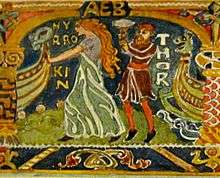Hyrrokkin


In Norse mythology, Hyrrokkin ("Fire-Smoked", possibly referring to a dark, shrivelled appearance[1]) is a giantess. She appears to be depicted on one of the surviving stones from the Hunnestad Monument near Marsvinsholm, Sweden called DR 284.
Hyrrokkin at Baldr's funeral
It is told in Snorri Sturluson's Gylfaginning that at Baldr's funeral his wife Nanna died of grief and was placed alongside him on his pyre, thus joining her husband in Hel. Hringhorni, Baldr's ship, was the largest of all such vessels and was to serve as the god's funeral ship. No one, however, could seem to launch the boat out to sea.
The gods then enlisted the help of Hyrrokkin, who came from Jötunheimr, arriving on a giant wolf with vipers as reins. When she dismounted, Odin summoned four berserks to look after the animal but they were unable to control it without first rendering it unconscious. With her seismic strength, the giantess rolled the boat into the water. This caused the earth to quake and the rollers to set on fire, which angered Thor. He was about to kill Hyrrokkin with his hammer Mjöllnir, but the other gods insisted that he spare her.
|
En æsirnir tóku lík Baldrs ok fluttu til sævar. Hringhorni hét skip Baldrs. Hann var allra skipa mestr. Hann vildu goðin fram setja ok gera þar á bálför Baldrs, en skipit gekk hvergi fram. Þá var sent í Jötunheima eftir gýgi þeiri, er Hyrrokkin hét. En er hon kom ok reið vargi ok hafði höggorm at taumum, þá hljóp hon af hestinum, en Óðinn kallaði til berserki fjóra at gæta hestsins, ok fengu þeir eigi haldit, nema þeir felldi hann. Þá gekk Hyrrokkin á framstafn nökkvans ok hratt fram í fyrsta viðbragði, svá at eldr hraut ór hlunnunum ok lönd öll skulfu. Þá varð Þórr reiðr ok greip hamarinn ok myndi þá brjóta höfuð hennar, áðr en goðin öll báðu henni friðar.Guðni Jónsson's edition |
The Æsir then took the dead body and bore it to the seashore, where stood Baldur's ship Hringhorn, which passed for the largest in the world. But when they wanted to launch it in order to make Baldur's funeral pile on it, they were unable to make it stir. In this conjuncture they sent to Jotunheim for a certain giantess named Hyrrokin, who came mounted on a wolf, having twisted serpents for a bridle. As soon as she alighted, Odin ordered four Berserkir to hold her steed fast, who were, however, obliged to throw the animal on the ground ere they could effect their purpose. Hyrrokin then went to the ship, and with a single push set it afloat, but the motion was so violent that the fire sparkled from the rollers, and the earth shook all around. Thor, enraged at the sight, grasped his mallet, and but for the interference of the Æsir would have broken the woman's skull. |
Hyrrokkin's death
While Thor was stopped from killing her at Baldur's funeral, Hyrrokkin is mentioned in a list of giants and giantesses killed by him, as told by Þorbjörn dísarskáld in Skáldskaparmál.
|
|
Attestations
The poem Húsdrápa, composed by Úlfr Uggason in Iceland in the late 10th century and partially preserved in the Prose Edda, refers to Hyrrokkin at Baldr's funeral:
- "The very powerful Hild of the mountains [giantess][2] caused the sea-Sleipnir [ship] to lumber forward, but the wielders of the helmet flames [warriors] of Hropt [Odin] felled her mount."
She is also mentioned in a list of troll women by an anonymous skald:
- Gjölp, Hyrrokkin,
- Hengikepta,
- Gneip ok Gnepja,
- Geysa, Hála,
- Hörn ok Hrúga,
- Harðgreip, Forað,
- Hryðja, Hveðra
- ok Hölgabrúðr.
See also
- Snake-witch stone, a picture stone depicting a female grasping two snakes
Notes
- ↑ Lindow, John (2001). Norse Mythology. Oxford University Press. ISBN 0-19-515382-0.
- ↑ Hild or Hildr in this context is simply a kenning for "giantess" generally and Hyrrokkin specifically.
References
- Faulkes, Anthony (transl.) (1987). Edda (Snorri Sturluson). Everyman. ISBN 0-460-87616-3
External links
| Wikimedia Commons has media related to Hyrrokkin. |